Understanding Equality, Diversity, and Rights in Health and Social Care
Added on 2023-04-21
39 Pages11619 Words342 Views
Running head: HEALTHCARE ASSIGNMENT
HEALTHCARE ASSIGNMENT
Name of the Student:
Name of the University:
Author Note:
HEALTHCARE ASSIGNMENT
Name of the Student:
Name of the University:
Author Note:
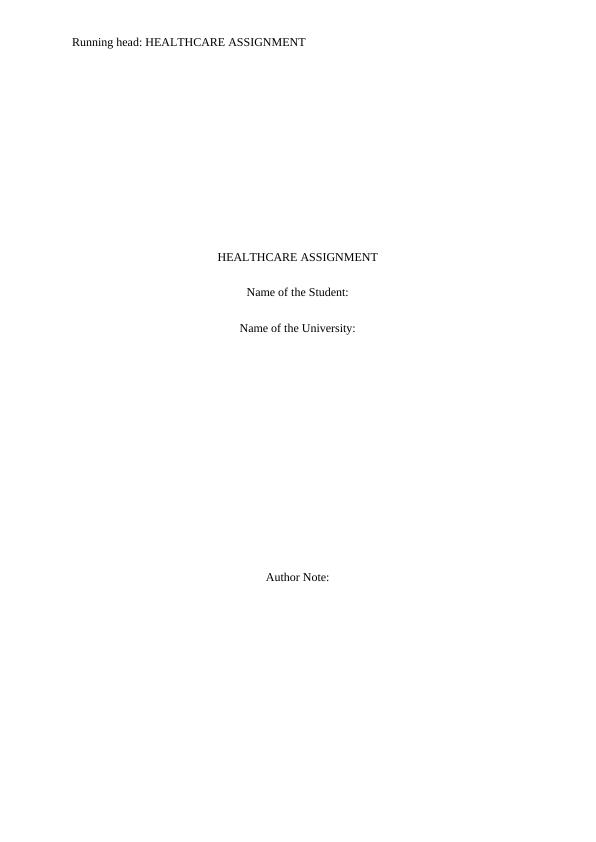
1HEALTHCARE ASSIGNMENT
Unit 1: Understand equality, diversity and rights and health and social care:
1.1: Define the following terms:
Equality: Equality can be defined as the state of being treated equal with regard to status,
rights or opportunities. Equality supports the legal framework and allows the consideration of
choices in the decision making process. By virtue of equality people tend to feel valued and
respected. Also, equality helps in accruing equal rights and equal opportunities to people so
as to assure everyone a similar legal status. The Equality Act protects the vulnerable groups
through equality legislation on age, disability, gender reassignment, race, religion, sex, sexual
orientation, marriage, maternity, civil partnership and pregnancy. These determiners across
which protection is guaranteed is also known as protected characteristics. The Act now
extends its protected characteristics to include disabled and gender reassignment (transsexual
people) and grants them equality across all domains of life (Hepple 2014).
Diversity: Diversity can be defined as the state of being different from others in terms of
cultural, religious, linguistic or ethnic background. Diversity allows people to celebrate the
existing differences with respect to culture and tradition and enables people to stay in
harmony with one another. Also, diversity enables people to respect each other’s difference
in custom and traditional beliefs.
Inclusion: Inclusion can be defined as the state of being included within a group. It generally
refers to the inclusion of disabled people or people with special needs in a group.On a
broader note, inclusion can be explained as accepting individuals with special needs and
treating them with dignity and respect. Inclusion means not to discriminate on the basis of
limited ability of the disabled individuals and treat them with integrity. The central idea of
inclusion is to socially include the disabled individuals in the society so as to alleviate their
standard of living and protect them from social discrimination.
Unit 1: Understand equality, diversity and rights and health and social care:
1.1: Define the following terms:
Equality: Equality can be defined as the state of being treated equal with regard to status,
rights or opportunities. Equality supports the legal framework and allows the consideration of
choices in the decision making process. By virtue of equality people tend to feel valued and
respected. Also, equality helps in accruing equal rights and equal opportunities to people so
as to assure everyone a similar legal status. The Equality Act protects the vulnerable groups
through equality legislation on age, disability, gender reassignment, race, religion, sex, sexual
orientation, marriage, maternity, civil partnership and pregnancy. These determiners across
which protection is guaranteed is also known as protected characteristics. The Act now
extends its protected characteristics to include disabled and gender reassignment (transsexual
people) and grants them equality across all domains of life (Hepple 2014).
Diversity: Diversity can be defined as the state of being different from others in terms of
cultural, religious, linguistic or ethnic background. Diversity allows people to celebrate the
existing differences with respect to culture and tradition and enables people to stay in
harmony with one another. Also, diversity enables people to respect each other’s difference
in custom and traditional beliefs.
Inclusion: Inclusion can be defined as the state of being included within a group. It generally
refers to the inclusion of disabled people or people with special needs in a group.On a
broader note, inclusion can be explained as accepting individuals with special needs and
treating them with dignity and respect. Inclusion means not to discriminate on the basis of
limited ability of the disabled individuals and treat them with integrity. The central idea of
inclusion is to socially include the disabled individuals in the society so as to alleviate their
standard of living and protect them from social discrimination.
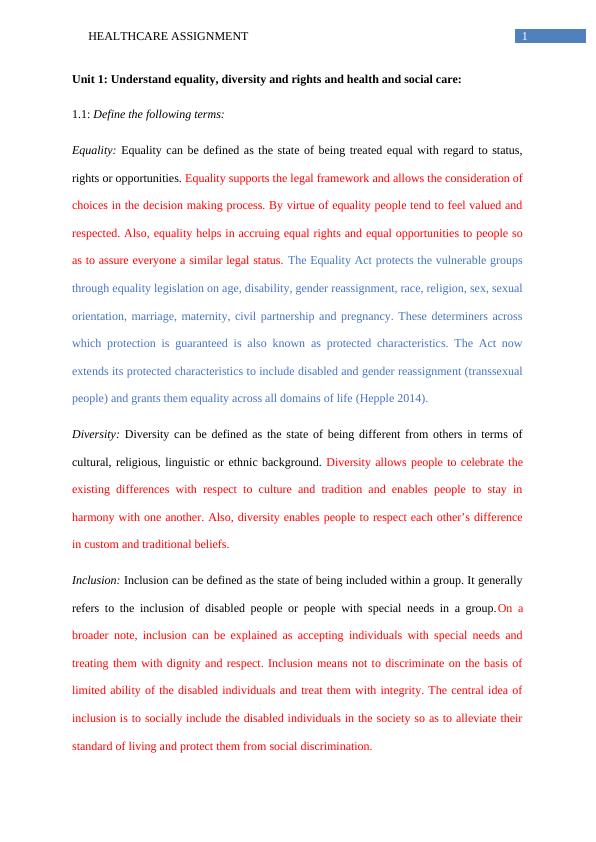
2HEALTHCARE ASSIGNMENT
Discrimination: Discrimination can be defined as an unjust or prejudicial treatment that
oppresses individuals belonging to different social categories of age, race, sex or
gender.Discrimination refers to the behaviour of making a unique distinction towards an
individual or a group of individuals on the parameters of age, colour, height, gender, ethnicity
or cultural preferences. Discrimination involves oppressing or restricting a particular group
from participating equally in the decision making process or depriving the group from a basic
opportunities to access the basic amenities of life. Discriminatory policies exist at the
individual level, organizational level and at the national level. According to the definition
propounded by the United Nations, discriminatory behaviours might assume many forms but
typically involve a form of exclusion or rejection.
1.2: Explain how rights are promoted in health and social care services
Health care services as well as social care services ensure proper access to support
and care facilities of people irrespective of the circumstances. The care professionals are
obliged to practice according to the code of conduct that stringently allows them to work in a
manner that promotes equality and diversity across their areas of practice. At the same time,
professionals also advocate the individual rights of the patients and act in the best interest of
the patient. Health care services critically ensure that patient privacy is protected and at the
same time the patients are protected against any harm or danger. In addition to this, care
services also treat patients in a fair and just manner and ensure that patients irrespective of
their demographic or cultural background have an equal access to care services and case
resources. Also, care professionals are expected to impart effective care services in a
culturally safe manner. The rationale can be explained as protecting the patient from any
potential harm which could elicit a negative implication on the health outcome of the patient
and at the same time treat the patient with respect and dignity in order to ensure equity in
terms of treatment services. In addition to this, across healthcare services, privacy of
Discrimination: Discrimination can be defined as an unjust or prejudicial treatment that
oppresses individuals belonging to different social categories of age, race, sex or
gender.Discrimination refers to the behaviour of making a unique distinction towards an
individual or a group of individuals on the parameters of age, colour, height, gender, ethnicity
or cultural preferences. Discrimination involves oppressing or restricting a particular group
from participating equally in the decision making process or depriving the group from a basic
opportunities to access the basic amenities of life. Discriminatory policies exist at the
individual level, organizational level and at the national level. According to the definition
propounded by the United Nations, discriminatory behaviours might assume many forms but
typically involve a form of exclusion or rejection.
1.2: Explain how rights are promoted in health and social care services
Health care services as well as social care services ensure proper access to support
and care facilities of people irrespective of the circumstances. The care professionals are
obliged to practice according to the code of conduct that stringently allows them to work in a
manner that promotes equality and diversity across their areas of practice. At the same time,
professionals also advocate the individual rights of the patients and act in the best interest of
the patient. Health care services critically ensure that patient privacy is protected and at the
same time the patients are protected against any harm or danger. In addition to this, care
services also treat patients in a fair and just manner and ensure that patients irrespective of
their demographic or cultural background have an equal access to care services and case
resources. Also, care professionals are expected to impart effective care services in a
culturally safe manner. The rationale can be explained as protecting the patient from any
potential harm which could elicit a negative implication on the health outcome of the patient
and at the same time treat the patient with respect and dignity in order to ensure equity in
terms of treatment services. In addition to this, across healthcare services, privacy of
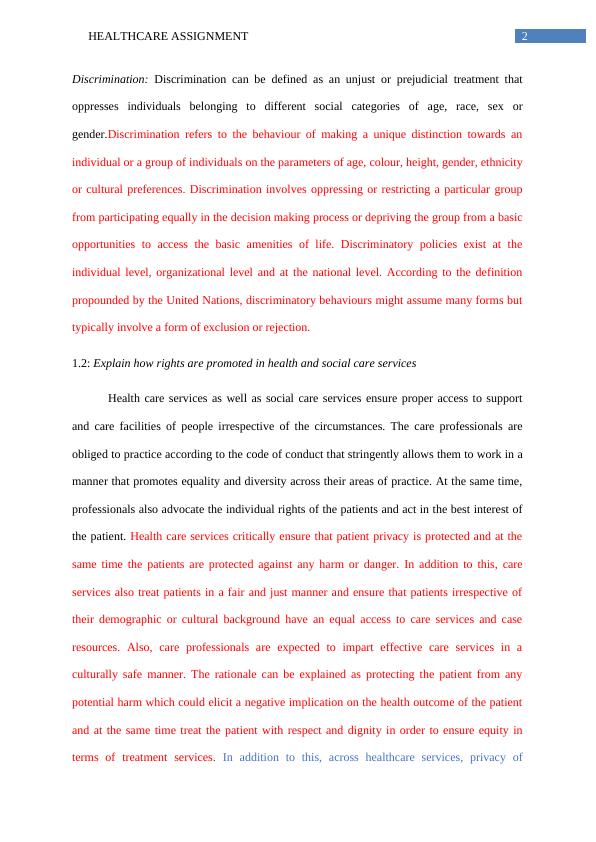
3HEALTHCARE ASSIGNMENT
individuals is respected and it is ensured that individuals are free from harm and danger.
Further, it is also ensured that individuals are treated in a fair manner and have access to
personal records, individual preferences as well as personal choices in relation to the
treatment process. The overall purpose of the promotion of rights is to ensure that people feel
respected and free from any potential threat or harm.
1.3: Discuss ethical dilemmas that may arise when balancing individual rights and duty of
care
Ethical dilemmas refer to conditions where the duty of care and the individual rights
of the patients do not go hand in hand. For instance, a condition when the care professionals
suspect that an individual is suffering from dementia and is harmed or threatened by a family
member, the ethical duty of the care professionals is to protect the individual from that family
member. The autonomy and wellness interest of the patient here is complex and benefits
associated with a long term relationship must be compared with the extent of harm that was
caused to the patient. The four ethical principles of autonomy, non-maleficence, beneficence
and justice help the carers to act in the best interest of the patient so as to foster effective care
delivery. Another instance of ethical dilemma can be explained in terms of what should be
disclosed to the family members of the patient. For instance, in end of life care decisions and
critical cases, patients often pester the nursing professionals to decipher what was conveyed
by the physician. In such instances, nurses are surrounded with the ethical dilemma that to
what extent the patient information should be conveyed. Also, disclosing medical information
forms another case of ethical dilemma. In certain cases, family members of the patients
request not to convey the information to the patient about a serious diagnosis so as to avoid
psychological stress. However, considering the legal obligation of the patient and the right to
know about the medical diagnosis raises a serious ethical dilemma where the nursing
professional must test the validity of the request made by the family members of the patient.
individuals is respected and it is ensured that individuals are free from harm and danger.
Further, it is also ensured that individuals are treated in a fair manner and have access to
personal records, individual preferences as well as personal choices in relation to the
treatment process. The overall purpose of the promotion of rights is to ensure that people feel
respected and free from any potential threat or harm.
1.3: Discuss ethical dilemmas that may arise when balancing individual rights and duty of
care
Ethical dilemmas refer to conditions where the duty of care and the individual rights
of the patients do not go hand in hand. For instance, a condition when the care professionals
suspect that an individual is suffering from dementia and is harmed or threatened by a family
member, the ethical duty of the care professionals is to protect the individual from that family
member. The autonomy and wellness interest of the patient here is complex and benefits
associated with a long term relationship must be compared with the extent of harm that was
caused to the patient. The four ethical principles of autonomy, non-maleficence, beneficence
and justice help the carers to act in the best interest of the patient so as to foster effective care
delivery. Another instance of ethical dilemma can be explained in terms of what should be
disclosed to the family members of the patient. For instance, in end of life care decisions and
critical cases, patients often pester the nursing professionals to decipher what was conveyed
by the physician. In such instances, nurses are surrounded with the ethical dilemma that to
what extent the patient information should be conveyed. Also, disclosing medical information
forms another case of ethical dilemma. In certain cases, family members of the patients
request not to convey the information to the patient about a serious diagnosis so as to avoid
psychological stress. However, considering the legal obligation of the patient and the right to
know about the medical diagnosis raises a serious ethical dilemma where the nursing
professional must test the validity of the request made by the family members of the patient.
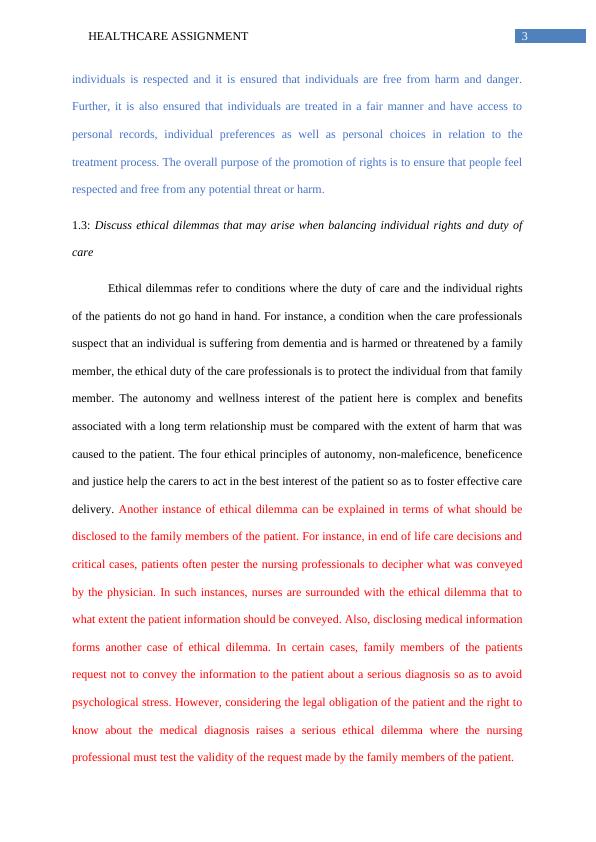
4HEALTHCARE ASSIGNMENT
Understand how to work in inclusive way:
2.1: Explain how to promote equality and support diversity
It is extremely important to promote equality and support diversity within a
workplace. A health work environment reflects inclusive practice and mutual respect for
cultural diversity (Baillie and Matiti 2013). A number of processes can ensure promotion of
equality and supporting diversity. Firstly, the staff and clients within an organization must be
treated in an equal and fair manner. Secondly, creation of an inclusive culture for the staff
and clients can help in promoting equality and supporting diversity. In addition to this,
ensuring equal access for all also helps in the promotion of equality. In addition to this,
enabling development of full potential of the staff irrespective of their cultural background
can help in promoting equality and supporting diversity. Also, procuring a safe and inclusive
environment and enforcing anti discriminatory policies and procedures can help in promoting
equality and supporting diversity.
Therefore, it can be mentioned that in order to promote equality and support diversity,
staff professionals working within an organization must treat everyone equally and create
an inclusive environment. In addition to this, at the administration level it must be
ensured that policy makers create policies and procedures that promote equality and
diversity. This means that the policies must not promote institutional discrimination and
must ensure that professionals working within the organization have equal access to
opportunities and enjoy professional freedom so as to work in harmony with one another.
2.2: Describe how to challenge those not working inclusive in a way that promotes change
On coming across an incident where it is detected that inclusive practice is not being
followed or is violated, the three primary steps can be taken (Dweck 2013). Firstly, a
Understand how to work in inclusive way:
2.1: Explain how to promote equality and support diversity
It is extremely important to promote equality and support diversity within a
workplace. A health work environment reflects inclusive practice and mutual respect for
cultural diversity (Baillie and Matiti 2013). A number of processes can ensure promotion of
equality and supporting diversity. Firstly, the staff and clients within an organization must be
treated in an equal and fair manner. Secondly, creation of an inclusive culture for the staff
and clients can help in promoting equality and supporting diversity. In addition to this,
ensuring equal access for all also helps in the promotion of equality. In addition to this,
enabling development of full potential of the staff irrespective of their cultural background
can help in promoting equality and supporting diversity. Also, procuring a safe and inclusive
environment and enforcing anti discriminatory policies and procedures can help in promoting
equality and supporting diversity.
Therefore, it can be mentioned that in order to promote equality and support diversity,
staff professionals working within an organization must treat everyone equally and create
an inclusive environment. In addition to this, at the administration level it must be
ensured that policy makers create policies and procedures that promote equality and
diversity. This means that the policies must not promote institutional discrimination and
must ensure that professionals working within the organization have equal access to
opportunities and enjoy professional freedom so as to work in harmony with one another.
2.2: Describe how to challenge those not working inclusive in a way that promotes change
On coming across an incident where it is detected that inclusive practice is not being
followed or is violated, the three primary steps can be taken (Dweck 2013). Firstly, a
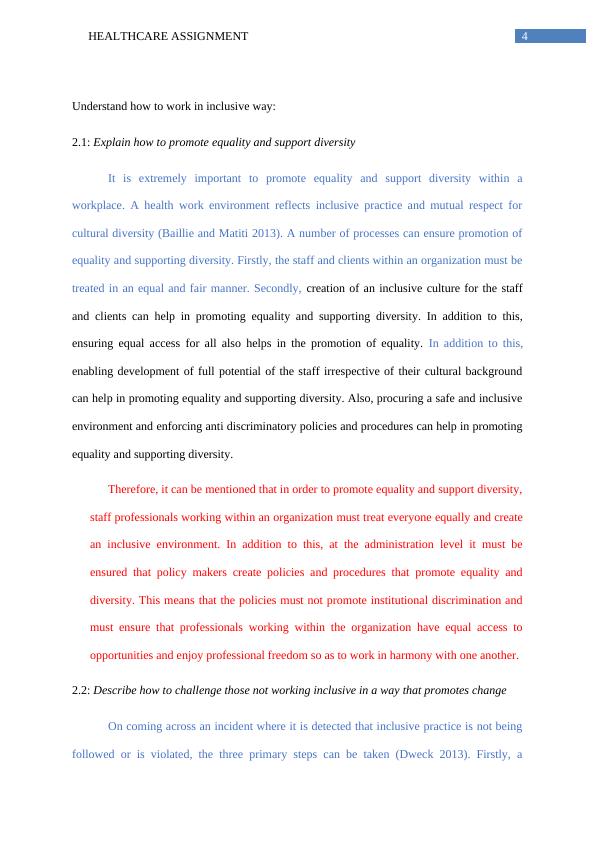
5HEALTHCARE ASSIGNMENT
complaint can be identified and registered to the employer of the organization in an informal
manner, secondly a grievance can be raised using the employee grievance procedure and
thirdly a claim can be made to the employment Tribunal for seeking justice.
The above discussed procedures are methods in which staff professionals not working in
an inclusive way can be identified and accordingly brought to notice of the higher authorities.
In addition to this, in order to resolve the issue, the supervisor could conduct a meeting and
explain to the professionals the importance of practicing in an inclusive manner so as to
withhold the vision of the organization. Further, the manager must bring to the notice of the
identified professionals their misconduct and can proactively conduct a counselling session to
explain them the true meaning of working in an inclusive manner. Further, the manager can
proactively work in close association with the employees and demonstrate practically the
manner in which the employees could work in an inclusive manner so as to foster a positive
work environment.
2.3: Explain how to support others in promoting equality and rights
In general the promotion of equality or rights within an organization is restricted to
the HR department. However, there are a number of ways which can help in promoting
equality and rights. These can be enlisted as follows (Deane 2013):
Report any form of discrimination
Actively volunteer for diversity events
Offer assistance with recruitment events
Voice innovative ideas
Obtain employee views
In addition to this, the organization can proactively share information about equality
rights of the employees and encourage employees to raise a concern upon sensing violation of
complaint can be identified and registered to the employer of the organization in an informal
manner, secondly a grievance can be raised using the employee grievance procedure and
thirdly a claim can be made to the employment Tribunal for seeking justice.
The above discussed procedures are methods in which staff professionals not working in
an inclusive way can be identified and accordingly brought to notice of the higher authorities.
In addition to this, in order to resolve the issue, the supervisor could conduct a meeting and
explain to the professionals the importance of practicing in an inclusive manner so as to
withhold the vision of the organization. Further, the manager must bring to the notice of the
identified professionals their misconduct and can proactively conduct a counselling session to
explain them the true meaning of working in an inclusive manner. Further, the manager can
proactively work in close association with the employees and demonstrate practically the
manner in which the employees could work in an inclusive manner so as to foster a positive
work environment.
2.3: Explain how to support others in promoting equality and rights
In general the promotion of equality or rights within an organization is restricted to
the HR department. However, there are a number of ways which can help in promoting
equality and rights. These can be enlisted as follows (Deane 2013):
Report any form of discrimination
Actively volunteer for diversity events
Offer assistance with recruitment events
Voice innovative ideas
Obtain employee views
In addition to this, the organization can proactively share information about equality
rights of the employees and encourage employees to raise a concern upon sensing violation of

6HEALTHCARE ASSIGNMENT
the employee rights. Further, encouraging effective communication between the team
members so as to strengthen team bonding can help in upholding the integrity of the
concerned profession. In addition to this, stringent monitoring of the work process so as to
ensure that employees work in accordance to the rules and law and promoting role model
working can help in supporting employees whose rights or laws are compromised.
Unit 2: Understand legislation and codes in relation to inclusive practice
3.1: Summarise legislation and codes of practice relating to equality, diversity, inclusion and
discrimination
The Equality Act passed in the year 2010 cumulatively addresses the previous acts that
were associated with equality and discrimination (Florian and Spratt 2013). This ACT is
applicable to all organizations and it critically ensures protection of the vulnerable groups of
individual from discrimination (Knowles 2013). It is expected that organizations dealing with
early year education must be aware of the law and foster adequate support for children with
disability or other developmental deformity so as to ensure equality and protection against
discrimination. In addition to this the staff members must procure a positive attitude towards
the disabled in order to reinforce an inclusive practice. Also, an organization must ensure that
all employees are treated equal to one another and work in an inclusive manner so as to
abstain from practicing any form of discrimination. In addition to this, the sex discrimination
act of 1975 was passed by the parliament of the United Kingdom which prevented the
discrimination of men and women on the grounds of marital status or sex
(Equalpayportal.co.uk 2019). This law involves equal social status of men and women
irrespective of their marital status and ensures equal legal rights to lead a life free from social
prejudice or belief in relation to marital status. Also, the Equal Pay Act of 1970, was passed
by the parliament of United Kingdom and it guaranteed wage equality between men and
the employee rights. Further, encouraging effective communication between the team
members so as to strengthen team bonding can help in upholding the integrity of the
concerned profession. In addition to this, stringent monitoring of the work process so as to
ensure that employees work in accordance to the rules and law and promoting role model
working can help in supporting employees whose rights or laws are compromised.
Unit 2: Understand legislation and codes in relation to inclusive practice
3.1: Summarise legislation and codes of practice relating to equality, diversity, inclusion and
discrimination
The Equality Act passed in the year 2010 cumulatively addresses the previous acts that
were associated with equality and discrimination (Florian and Spratt 2013). This ACT is
applicable to all organizations and it critically ensures protection of the vulnerable groups of
individual from discrimination (Knowles 2013). It is expected that organizations dealing with
early year education must be aware of the law and foster adequate support for children with
disability or other developmental deformity so as to ensure equality and protection against
discrimination. In addition to this the staff members must procure a positive attitude towards
the disabled in order to reinforce an inclusive practice. Also, an organization must ensure that
all employees are treated equal to one another and work in an inclusive manner so as to
abstain from practicing any form of discrimination. In addition to this, the sex discrimination
act of 1975 was passed by the parliament of the United Kingdom which prevented the
discrimination of men and women on the grounds of marital status or sex
(Equalpayportal.co.uk 2019). This law involves equal social status of men and women
irrespective of their marital status and ensures equal legal rights to lead a life free from social
prejudice or belief in relation to marital status. Also, the Equal Pay Act of 1970, was passed
by the parliament of United Kingdom and it guaranteed wage equality between men and

7HEALTHCARE ASSIGNMENT
women (Equalpayportal.co.uk 2019). This law critically ensures equality of wages of men
and women and equal employee rights so as to acquire equal status before the court of law.
Finally the Equality Act passed in the year 2010 replaced these anti-discrimination laws with
a single Act which simplified the complexities and made it easier for people to understand the
meaning of equality in every sphere of life and comply with it (Equalpayportal.co.uk 2019).
This act came into force on October 1, 2010 and assures equality on the basis of pay scale,
discrimination and marital status and other opportunity.
Understand role of health and social care practitioner in inclusive practice:
4.1: Evaluate the role of the health and social care practitioner in meeting individual’s needs
through inclusive practice
It is important for the care professionals to possess excellent communication skills as
communication is an integral medium to exchange information with the disabled
individual and build an effective therapeutic relationship (Hagquist and Hellstrom 2014).
In addition to this, the health care practitioner as well as the social care practitioner must
adapt a positive attitude towards the disable d and interact with them in a humble manner
so as to ensure a positive inclusive practice. Utmost care should be taken to ensure that
factors that are detrimental to inclusive practice are uprooted. These factors include
discrimination such as verbal abuse or attending disabled patients poorly. In addition to
this, time constraints, staff changes, poor financial resources, lack of proper training and
resources, lack of knowledge about person-centred care and failing to identify the cultural
and religious specific need of the patients could cumulatively lead to poor patient
outcome. The strengths of inclusive practice include a through consideration of the above
factors and adapting a person centred care approach so as to acquire positive patient
outcome. Research studies have mentioned that inclusion of family centred practice and
women (Equalpayportal.co.uk 2019). This law critically ensures equality of wages of men
and women and equal employee rights so as to acquire equal status before the court of law.
Finally the Equality Act passed in the year 2010 replaced these anti-discrimination laws with
a single Act which simplified the complexities and made it easier for people to understand the
meaning of equality in every sphere of life and comply with it (Equalpayportal.co.uk 2019).
This act came into force on October 1, 2010 and assures equality on the basis of pay scale,
discrimination and marital status and other opportunity.
Understand role of health and social care practitioner in inclusive practice:
4.1: Evaluate the role of the health and social care practitioner in meeting individual’s needs
through inclusive practice
It is important for the care professionals to possess excellent communication skills as
communication is an integral medium to exchange information with the disabled
individual and build an effective therapeutic relationship (Hagquist and Hellstrom 2014).
In addition to this, the health care practitioner as well as the social care practitioner must
adapt a positive attitude towards the disable d and interact with them in a humble manner
so as to ensure a positive inclusive practice. Utmost care should be taken to ensure that
factors that are detrimental to inclusive practice are uprooted. These factors include
discrimination such as verbal abuse or attending disabled patients poorly. In addition to
this, time constraints, staff changes, poor financial resources, lack of proper training and
resources, lack of knowledge about person-centred care and failing to identify the cultural
and religious specific need of the patients could cumulatively lead to poor patient
outcome. The strengths of inclusive practice include a through consideration of the above
factors and adapting a person centred care approach so as to acquire positive patient
outcome. Research studies have mentioned that inclusion of family centred practice and
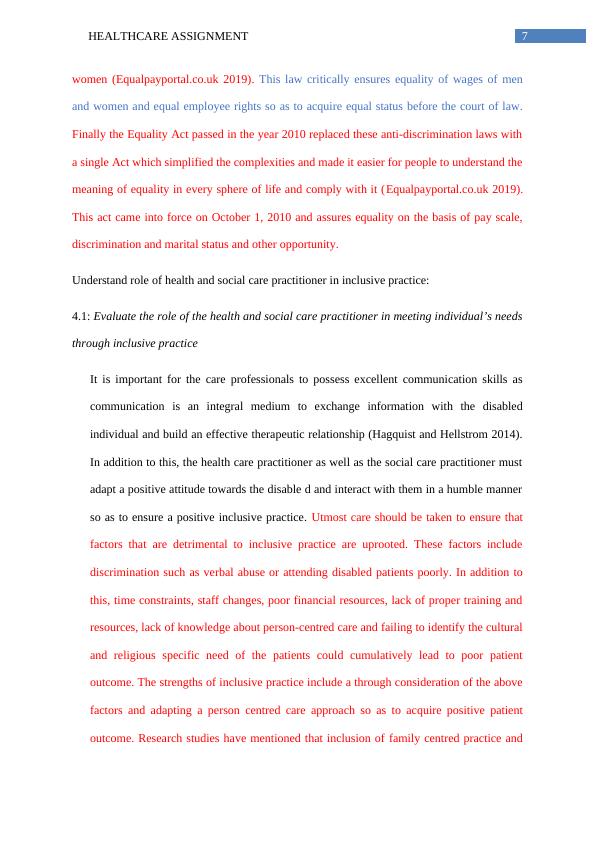
End of preview
Want to access all the pages? Upload your documents or become a member.
Related Documents
Equality, Diversity and Inclusion: Understanding the Concepts and Importancelg...
|5
|2314
|350
Concepts of Equality, Diversity and Rights in Relation to Health and Social Carelg...
|7
|512
|313
UNIT 2: Equality, Diversity and Rights in Health and Social Carelg...
|8
|2057
|112
Equality, Diversity and Inclusion in Health and Social Carelg...
|10
|894
|39
Assignment on Age Discrimination Act of 2004 in Australialg...
|7
|1980
|80
Factors Influencing Learninglg...
|20
|5754
|56
